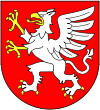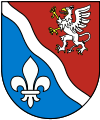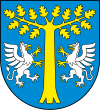Dębica
| Dębica | |||
|---|---|---|---|
 | |||
| |||
 Dębica | |||
| Coordinates: 50°3′N 21°25′E / 50.050°N 21.417°E | |||
| Country | Poland | ||
| Voivodeship |
| ||
| County | Dębica County | ||
| Gmina | Dębica (urban gmina) | ||
| Established | 13th century | ||
| Town rights | 1358 | ||
| Government | |||
| • Mayor | Mariusz Szewczyk | ||
| Area | |||
| • City | 34.14 km2 (13.18 sq mi) | ||
| Highest elevation | 407 m (1,335 ft) | ||
| Lowest elevation | 176 m (577 ft) | ||
| Population (2008) | |||
| • City | 47 234 | ||
| • Density | 1,413.52/km2 (3,661.0/sq mi) | ||
| • Metro | 75,000 | ||
| Time zone | CET (UTC+1) | ||
| • Summer (DST) | CEST (UTC+2) | ||
| Postal code | 39-200 to 39-210 | ||
| Area code(s) | +48 14 | ||
| Car plates | RDE | ||
| Website | http://www.debica.pl | ||
Dębica ([dɛmˈbit͡sa]; Yiddish: דעמביץ Dembitz) is a city in southeastern Poland with 46,693 inhabitants, as of 2 June 2009.[1] It is the capital of Dębica County. Since 1999 it has been situated in the Podkarpackie Voivodeship; it had previously been in the Tarnów Voivodeship (1975–1998). Dębica belongs to the historic province of Lesser Poland, and for centuries it was part of the Sandomierz Voivodeship.
Area and location
According to the 2006 data, Dębica's area is 33.81 square kilometres (13.05 sq mi). Arable land makes 42% of the area of the town, while forests make 19%. Dębica is the seat of the county, and the town covers 4.34% of the county's area. Dębica lies at the border of two geographical regions of Poland - the Carpathian Piedmont in southern districts of the town, and the Sandomierz Basin in its north, along the Wisłoka river.
Economy
Since the mid-1930s Dębica, in spite of its size, has been a large industrial hub. A number of companies were then created thanks to governmental industry development programs. Most of them still exist today, though they were privatized in the 1990s:
- Firma Oponiarska Dębica S.A. (Tire Company Dębica) now owned by Goodyear Tire and Rubber Company, previous name - Stomil Dębica
- Lerg S.A. - a chemical manufacturer located in the village of Pustkow, a village in Dębica County
- Tikkurila Polska S.A. (formerly Polifarb Debica) - a paint manufacturer
- Wytwornia Urzadzen Chlodniczych WUCh (Freezer Appliances Producer WUCh)
- Zaklady Miesne (Meatworks)
Since the early 1990s a relatively large number (in proportion to the city's size) of successful companies have been started and run by local residents:
- bicycle, motocycle and electric car manufacturer Arkus and Romet Group
- Sportatut - producer of sports nutritionals
- chemical industry manufacturers (paint producers such as Sniezka Brzeznica and Plastbud Pustkow)
- marble producer Jabo Marmi and brickyard Iglobud
- Food companies such as Igloomeat and Animex Poludnie
Transport
The A4 highway runs just to the north of the city. There are two exits from the highway into Dębica. The section of the highway going westwards from Dębica to Tarnów was completed in October 2014.[2] In result, the city has now a direct highway connection with the western Polish border and in consequence with all of Western Europe. A car journey to Kraków (approximately 120 km) takes around an hour, while Rzeszow, the capital of the Subcarpathian Voivodeship located to the East of Debica, can be easily reached in less than 30 minutes.
Dębica is also located by the 94 country road, which was formerly part of the European route E40. This two-lane road has been renovated in recent years. However, with the completion of the A4 highway, it lost its former significance. Dębica is also connected with the cities of Mielec and Tarnobrzeg thanks to the local road number 985.
Debica lies by an important railway line stretching between the western and eastern Polish borders. It is currently undergoing an upgrade (to be completed by 2016) for the maximum train speeds of 160 km/h. As of now due to the construction work, a 111 km train journey to Kraków takes approximately 1.5 hours.
Education
Debica has been home to two branches of higher education institutions:
- Wyższa Szkoła Informatyki i Zarządzania in Rzeszów, branch in Dębica
- University of Economics in Kraków, branch in Dębica
History

One of the oldest documented references to this area dates back to the year 1293. It records a settlement by the name of Dambicha, belonging to the noble Gryfita family.[3] In 1305, the village was raided by the Tatars, who burned a wooden church. The church was rebuilt in 1318, and by 1325, Dębica was the seat of a deanery, located on the outskirts of the mighty Sandomierz Wilderness. The Dębica Deanery consisted of fourteen parishes, among them Przecław, Sędziszów Małopolski, and Strzyżów.
In 1358 King Kazimierz Wielki gave a local nobleman Świętosław Gryfita a permission to found a town, and Dębica received Magdeburg rights, together with a privilege to organize weekly markets on Wednesdays.[3] The town however, was not actually founded until June 10, 1372, when Mikołaj of Lipiny was named its first wójt. Dębica was conveniently located along the main merchant route from Kraków to Lwów, but the newly established town was unable to compete with older urban centers of the area, Pilzno and Ropczyce. In 1446, King Władysław Warneńczyk allowed annual fairs to be organized on Ash Wednesdays, which resulted in quick development of the town. For many years however Dębica was a small place, located in the Pilzno County, Sandomierz Voivodeship, province of Lesser Poland. Lacking a defensive wall that would defend it, it was vulnerable to invasions of the Tatars, Swedes, and Hungarians, who burnt or ransacked the town every few years. As a result of these events, there are few historical monuments in Dębica. One of these is the Saint Jadwiga church, originally from the 14th century, but completely rebuilt in the late 19th century.

In 1474, Dębica, together with other towns of southern Lesser Poland, was ransacked by the Black Army of Hungary. In 1502, a Crimean Tatar raid caused widespread destruction, and as a result of it the town was burned and depopulated. To prevent complete disappearance of Dębica, its owners extempted residents from all taxes for 14 years, also allowing them to collect free timber and firewood in local forests. In 1504, Dębica was extempted from royal taxes by King Aleksander Jagiellończyk. Due to all these privileges, Dębica emerged in the 16th century as a local center of skilled craftsmen. Still, it was much smaller than Pilzno and Ropczyce, also because it remained a private town, whose owners argued with each other. In 1554, most of Dębica burned, together with a wooden parish church of St. Margaret. In the late 16th century, the population of the town was app. 700.
Like almost all Lesser Poland’s towns and cities, Dębica was completely destroyed in the Swedish invasion of Poland, when Swedes and Transilvanians of George II Rakoczi burned and ransacked the town (1655 - 1660). After the invasion, the population of Dębica was reduced to app. 200, with only 30 houses. As a result, the owners of the town allowed first Jews to settle in Dębica. First settlers arrived in 1676–1690. They expanded the town's population, and had a positive influence on the town's economy.[3]
In the late 17th century, the so-called New Dębica was established, around the now non-existing St. Barbara church, app. one kilometer (0.62 miles) west of Old Dębica. Both Dębicas had two different mayors, who were governed by one wójt. In the course of the time, the towns merged, and the market square of New Dębica now serves as the center of the town. Dębica was completely destroyed during the Great Northern War, and the destruction was so severe that the town slowly turned into a farming village. In the late 18th century, it belonged to the Radziwiłł family. A battle between Poles and Russians took place here during the Bar Confederation, and in 1772 (see: Partitions of Poland), Dębica was annexed by the Habsburg Empire, as part of Galicia, where it remained until November 1918. Austrian authorities decided that it should no longer be regarded as a town, but rather a village and renamed it Dembitz. This decision marked the decline of the town.[3]
Bad times came to an end in the second half of the 19th century, when Austrian government decided to build a main West-East railroad line (see Galician Railway of Archduke Charles Louis), connecting two major urban centres of Galicja - Kraków and Lwów. A railroad station was built in Dębica, and at the end of the 19th century, another, northbound line was constructed, joining Dębica and the town of Sandomierz, which was located on the Austrian-Russian boundary. The town became a rail junction, which was a huge boost for its citizens. In 1900 a high school was opened, and in 1908 students from this school founded one of the oldest sports clubs in Poland, Wisłoka (whose name comes from the River Wisłoka, which flows by the town). Just before World War I, Dębica was again incorporated as a town. The war was a disaster for the town, as it was almost completely destroyed. During several campaigns Dębica was occupied by Russian, Austrian, Hungarian and German troops, which fought in this area for many months in 1914 - 1915. The Russians wanted to get through the Carpathian Range towards Slovakia, Bohemia and Hungary, while the Central Powers managed to stop them at the beginning of 1915. These events had a great impact on the town and hampered its development for many years.
In 1918, after Poland regained independence, Dębica was included in the Kraków Voivodeship (1919-1939), in the county of Ropczyce. The economic situation of the town did not change - there was no industry, very few jobs available and surrounding villages were strongly overpopulated. This started to change in 1936, when Polish government announced creation of Central Industrial Area. It was a huge public works project, aimed at fighting unemployment in this overpopulated part of Poland, as well as creating heavy industry, concentrated on production of armament. Dębica started to develop very fast; so fast, that in 1937 the county's capital was moved here from Ropczyce. Among several factories built in the town at that time, the most important was Stomil (now called Tire Company Dębica, and belongs to the Goodyear). Other factories were: Wytwórnia Urządzeń Chłodniczych WUCh and Zakłady Tworzyw Sztucznych "Pustków", built from scratch, together with workers' settlement, in Pustków Osiedle, 15 kilometres (9.3 mi) northeast of Dębica. Some time in 1938 or 1939 works on another rail connection from Dębica to Jasło, via Pilzno were started. the Second World War stopped this construction, and after the war it was not continued.
World War II
The occupation of Dębica by Nazi Germany started on September 8, 1939. The Germans created a ghetto for town's Jewish population, eventually killing most of them either on the spot or in Auschwitz concentration camp. In the forested hills south of the town, strong underground forces operated, with numerous units of the Home Army (AK). It was too dangerous for AK's officers to stay in Dębica, thus the headquarters of a local underground district (known as Deser) were located at a nearby village of Gumniska, located in the hilly area south of the town. Resistance fighters were very active here, often attacking the main Kraków-Lwów rail line, used by German troops. In early 1944, units of local Armia Krajowa district unsuccessfully tried to blow up a train with Hans Frank, which was passing through the village station at Czarna Tarnowska, some 15 kilometres (9 miles) west of Dębica. As a reprisal, on February 2, 1944, the Germans murdered 50 Poles by rail track in Dębica (also see Otto Schimek).
HL-Heidelager
On the outskirts of Dębica in the village of Pustków near Blizna and several neighbouring ones, the Germans established a massive military base in the fall of 1941 for weapon's testing and the training of new Ukrainian collaborationist military formations including the SS Galizien Division.[4] It is estimated that in the duration of the SS Heidelager training base operation, some 15,000 slave-labor prisoners perished there including 7,500 Jews, 5,000 Soviet POWs, and 2,500 Poles; on top of an estimated 1,000 Soviet soldiers who died in the area during the Nazi-Soviet war. Their remains are buried in the cemetery along the road to Pustków Drips. Originally the cemetery was located inside the ring IV (Dąbrówki). Later the graves of soldiers were exhumed and moved. In one of the tombs is buried a Russian colonel killed in the fighting.[5]
Implicated in war crimes was the SS-man Alois Kurz (ID 382378) who, from 1940 to 21 April 1941, served in the SS Regiment Westland, then was assigned to a construction battalion for the SS training ground and labor camp serving the SS Truppenubungsplatz Heidelager (de) in Pustków. Also implicated in war crimes was Wilhelm Schitli, Commander of the "Jewish camp" at the SS training area HL-Heidelager from October 1942 to September 1943.[6]
Post-war
After the war, in new, Communist Poland, Dębica again became seat of a county, but the town was moved from Kraków to Rzeszów Voivodeship. In 1946, an execution of anti-communist activists took place there (Public execution in Dębica (1946)). War destruction again stopped town's development, but recovery this time was fast and based on pre-war factories. In 1975, after administrative reform, counties in Poland ceased to exist and were replaced by numerous and small Voivodeships. Dębica again was moved - this time from Rzeszów to the newly created Tarnów Voivodeship. In the late 1970s Dębica gained importance as a centre of food and agriculture production. This was due to creation of Kombinat Rolno-Spozywczy Igloopol, which, under an influential Communist dignitary Edward Brzostowski, developed very fast. Igloopol built a huge factory and a completely new district, with numerous condominiums, located on the northern side of rail line. The company achieved its peak in the late 1980s. After collapse of Communist regime, it was divided into several smaller firms, controlled by former Communist activists.
Sports
There are two major sports clubs in Dębica. Klub Sportowy (Sports Club) Wisłoka, founded in 1908, is one of the oldest sports organizations in the country. Wisłoka is famous for its wrestlers, who have won numerous medals in the Olympic Games, World and European Championships. Other fields in which Wisłoka's athletes achieved significant achievements are: soccer, boxing, cycling and karate. The club was sponsored by Tire Company Dębica and it had its heyday in the 1970s.
Other team, Ludowy Klub Sportowy Igloopol, was founded in 1978 and is the brainchild of a prominent activist of Polish communist party, Edward Brzostowski. Igloopol enjoyed strong support from the local government. Brzostowski was for some time Minister of Agriculture and director of Polski Zwiazek Pilki Noznej (Polish Football Association), so his favorite team prospered in soccer as well as in boxing, achieving significant successes. Igloopol's best years, late 1980s, are closely associated with peak of its sponsor.
Lately, both teams played in regional, Subcarpathian 4th Division, hoping to win promotion. Finally, Wisłoka achieved this goal and in the season 2006/2007 plays in the fourth group of Polish 3rd Division.
Famous personalities connected with Dębica
Dębica is the birthplace of 20th century composer Krzysztof Penderecki. Other personalities connected with the town are:
- Teresa Orlowski, Polish film star and producer
- Tadeusz Łomnicki, one of the most popular Polish actors, who attended Dębica's high school,
- Greco-Roman wrestlers, twins Kazimierz Lipień and Józef Lipień, who while representing Wisłoka in the 1970s, won numerous medals in various international tournaments, including the Olympic Games
- Leszek Pisz, a midfield soccer player, who started his career in Wisłoka. He played in Igloopol, Legia Warszawa, several Greek teams and in Polish National Team
- Mateusz Borek, famous sports commentator
- Władysław Strumski, Polish writer
- Ryszard Siwiec, born in Dębica, who committed suicide by self-immolation in protest against the Soviet-led invasion of Czechoslovakia
- Seweryn Gancarczyk, football defender
- Waldemar Piatek, football goalkeeper
- Jerzy Żuławski, who died in Dębica and was buried there
- Paweł Wolak, professional boxer, nicknamed "The Raging Bull"
| Wikimedia Commons has media related to Dębica. |
International relations
Twin towns - Sister cities
See also
References
- ↑ "Population. Size and structure by territorial division" (PDF). © 1995-2009 Central Statistical Office 00-925 Warsaw, Al. Niepodległości 208. 2009-06-02. Retrieved 2009-06-22. External link in
|publisher=(help) - ↑ http://www.gddkia.gov.pl/pl/a/16888/A4-dluzsza-o-35-km-Otwarto-odcinek-z-Tarnowa-do-Debicy. Retrieved 2014-10-30. Missing or empty
|title=(help) - 1 2 3 4 Urząd Miejski w Dębicy (2011). "Urząd Miejski w Dębicy - oficjalna strona internetowa". debica.pl. Retrieved 1 October 2011.
- ↑ "HL-Heidelager: SS-TruppenÜbungsPlatz" (with collection of historical photographs). Historia poligonu Heidelager w Pustkowie (in Polish). Pustkow.Republika.pl. 2013. Retrieved 6 July 2013.
- ↑ "Historia poligonu Heidelager". Pustkow.republika.pl. Retrieved 2013-03-12.
- ↑ "Detailansicht". www.kz-gedenkstaette-neuengamme.de. Retrieved 2013-03-12.
- 1 2 3 4 5 6 7 8 9 10 11 "Partnerstwo Samorządów Siłą Europy". Europa Miast (in Polish). Retrieved 2013-08-13.
- 1 2 3 4 5 6 7 "Dębica - Miasta Partnerskie" [Dębica - Partnership Cities]. Rząd Miejski w Dębicy - Współpraca - Europa Miast [Dębica town council in cooperation with Europa Miast] (in Polish). Archived from the original on 2011-10-11. Retrieved 2013-08-13.
Coordinates: 50°03′N 21°25′E / 50.050°N 21.417°E



